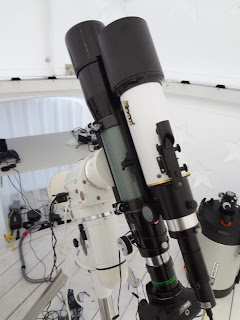Lately I've been testing the effects of sky glow of photography and photometry from my observatory. I had some decent success with the Delphini NOVA but overstaruated some of the pixels so didn't get any very useful data. Since then I've done a bit of deep sky photography but mostly focused on the moon and sun.

Dumbbell Nebula
The image to the right is the dumbbell Nebula taken from suburban Edmonton. Remarkably this image is unfiltered so nothing was blocking the light from the city. This was taken with the 11" SCT (before being put into hibernation) and is made up of just over an hour of 2 minute sub-exposures using a modified Canon T3i.
Ring Nebula
I also tested the optics/light pollution on the Ring Nebula because its a reasonably bright target that happens to be conveniently located right now. This was also about an hour of 2 minute sub-exposures.
In addition to those deep sky images I've also taken some pictures of the Moon with my Lumenera 135m video camera. They've turned out quite well and I'm hoping to get a full 'lunar portrait' of all the different phases of the moon.
The last image I took was with the Lumenera and a small solar filter. This white light picture of the sun is actually two different images that were combined using photoshop. The individual images were made up of 1000 images aligned and stacked in Registax.
I'm definitely hoping to make more use of the new observatory but for the time being I'm just trying to keep my head above water with the new baby!





